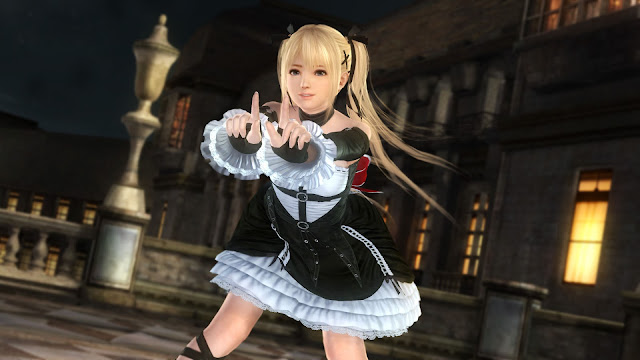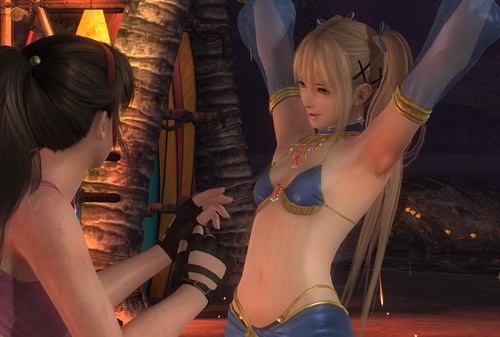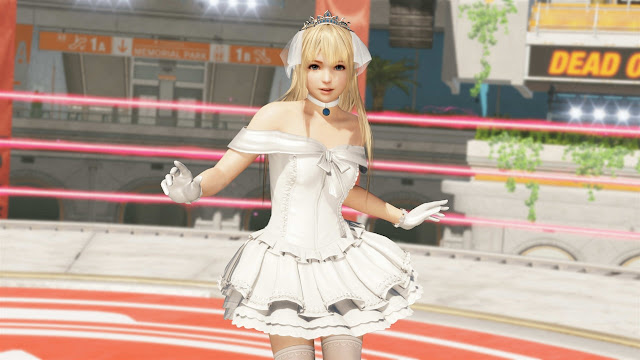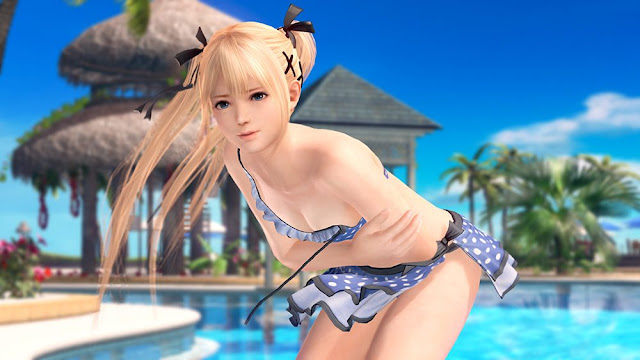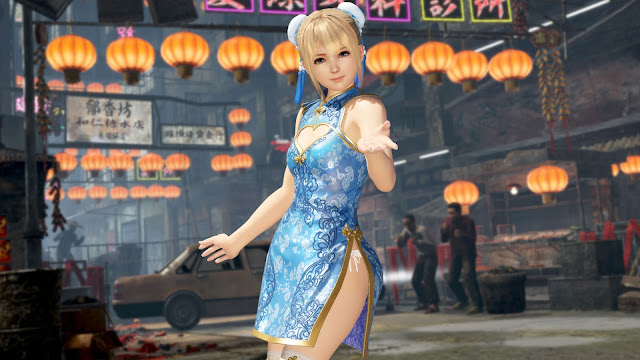With a waif-like, petite figure, long blonde hair tied in the twintails fashion, and a flowery dress in the style of Japan’s popular “Gothic Lolita” style, Marie Rose was – and still is – a very different type of character to the other women that we see in Dead or Alive. For a series infamous for its big-breasted women and pin-up tone to then provide players with an option that so completely embraced cuteness was surely a creative risk. This is particularly true of markets outside of Japan, where people are as a rule far less comfortable with “cute” and “sexy” being in the same proverbial ballpark.
But the team at Koei Tecmo knew they needed something very different… and weren’t really concerned about how western audiences would respond to Marie Rose. She was, after all, designed for an arcade game, and with arcades being dead outside of Japan, there was little chance of any of us seeing that in action.
“With the return of Dead or Alive to arcades, it was necessary to have a new star that would in many ways destroy the existing character roster… we wanted to encourage people to have a reason to go to the arcades,” Saito Yutaka, art director on Dead or Alive 5 series and Dead or Alive 6, said. “We were looking for a character that would subvert the concept of the female characters in Dead or Alive, because even we were feeling restricted by them.
“The arcade version was only released in Japan, so unlike the worldwide focus we had for Dead or Alive 5 and Dead or Alive 5 Ultimate, we were able to really focus on what the Japanese players would want for the newest female character,” Shimbori Yohei, director and producer for Dead or Alive 6, and producer on both Dead or Alive 5 series and Dead or Alive Xtreme 3 said.
“Dead or Alive has, for all its history, been known for its female characters being large breasted, and we wanted to change that history.”
And change it Koei Tecmo did. Following Marie Rose’s release in that arcade game, her popularity was immediate, and she quickly moved from being an arcade-only character to being added to the Dead or Alive 5 roster. Then, as Koei began preparing to work on Dead or Alive Xtreme 3 (the sub-series that does away with the fighting game side of things entirely to be a pure pin-up experience) the team put a popularity poll to fans to determine which characters should appear in the game. Marie Rose won over other characters that have been a part of the series from the start.
Recognising that they have a winner in Marie Rose, Koei Tecmo now plasters her over the cover of its games. She was one of just a handful of Dead or Alive characters that made an appearance in the Warriors cross-over, Warriors All-Stars, and there is plenty of merchandise made featuring her. Every year at TGS Koei Tecmo’s booth is filled with new Marie Rose tapestries, clear files, and other goods to buy. Koei Tecmo even partnered up with Crypton to draw up some promotional art of Marie Rose and Hatsune Miku hanging out in their swimwear together.
It’s safe to say that Marie Rose has transcended her role as a fighting game character to become a digital celebrity and a face of the Koei Tecmo brand. While the company expected that fans would respond positively to her, Shimbori said that he was a little surprised in just how popular Marie Rose has turned out to be.
“We weren’t concerned about putting Marie Rose out there, even though she is different to the rest of the Dead or Alive cast,” Shimbori said. “Even during development, I heard a lot of comments of her being cute from the people that were working on creating her, so I was confident that she would be a hit with the younger generation in Japan.
 |
| Marie Rose premium figure |
“I was however surprised that her popularity spread as much as it has – that wasn’t expected. She also became a topic overseas, which we didn’t anticipate given her role was originally for a Japan-only arcade game. Her popularity worldwide was well beyond my expectations. Cuteness must be something that’s appreciated by everyone!”
For Saito’s part, it was one particular anecdote in development that he remembers as being the moment he knew that the team was on to something special. “When we completed the scene where Marie pretends to cry we showed it to various staff that weren’t involved in the game,” he said. “All of them had a huge smile on their faces. That’s the moment I knew we had created a star.”
On Creating Marie Rose
As Saito said, the intent behind Marie Rose was to create a character radically different to what fans had seen previously in Dead or Alive. “In order to succeed, it’s not just about thinking about the existing fan base and limiting ourselves to small changes. There’s also the need to take the bold move and come up with an all-new set of values,” he said.
The games industry has always been a fascinating and nearly unique mix of technology and artistic creativity, and Marie Rose is a direct example of that. Her genesis was not in the mind of a single artist, nor was she initially inspired by a trip to an art gallery, a personality from history, or, given Dead or Alive’s close association with the pin-up aesthetic, fashion photography or gravure models.
No, Marie Rose was “born” when the team approached character design as a Web design firm would approach a project they were undertaking for a corporate clients: They talked about keywords.
“From a number of candidates that we thought would give us a fresh new approach to Dead or Alive characters, we narrowed it down to three keywords; “Gothic Lolita,” “twin-tailed,” and “small chested,” Saito said. “It was the first time that we created character details from words like this, instead of starting by determining their fighting style or personality. Her figure and hair colour are a result of taking these three keywords and examining them from many different angles.
“Marie Rose’s personality, style of speech, and so on, all came from numerous meetings around this common character image… and they came together quite naturally as the design of her progressed.”
As for Marie Rose’s now-iconic dress – it was actually something that Koei Tecmo had wanted to bring into the series for a while, though it lacked a character that suited that design element, Shimbori said. “The keyword we were working with wasn’t simply “Lolita,” but rather “Gothic Lolita.” It’s really important to note that,” he said. “We had tried that type of outfit in the game in the past, but it didn’t suit any of the characters up until that point. But an outfit with a big rose that is connected to what Marie Rose says – and her name – gives the character a mysterious element that we thought made it interesting.”
Web design firms always target keywords for the purposes of Search Engine Optimisation (SEO). Essentially, the film researches up what search words and phrases (the keywords) are most popular for that particular brand’s products and services, and then writes Web copy – the words that you see on a website – to emphasise these keywords and thus catch Google’s attention so that when someone searches for that particular keyword the company’s Website will appear on the top of the search. According to Shimbori, the decision to design those keywords was done for exactly the same reason. “To begin with, we collected a lot of keywords that were in popular demand,” he said. “At the time, these three terms were determined to be undoubtedly in high demand among the young generations in Japan.”
That should come as no surprise, given the rapid rise of Hatsune Miku as the leading digital celebrity over the last decade. She, too, features long twin-tail hair (though she’s not a blonde), a petite figure and small chest. Hatsune Miku is almost certainly a big part of the reason that those keywords were determined to have been in demand in Japan, meaning that Miku is in some ways the template and inspiration for Marie Rose. You could call them sisters, even.
So just as Google’s heavily scientific and data-driven algorithms ensure that when you’re searching for a burger or pizza, you’re going to find the right restaurant for your tastes instantly, Koei Tecmo guaranteed the success of Marie Rose as a character by making sure she hit every note that players were looking for in not just a fighting game character, but a digital celebrity. After all, her fighting style and role in Dead or Alive only came after the character was designed.
Marie Rose: Scientifically designed to love
The comparisons between Marie Rose and Hatsune Miku don’t stop there, either; both are quite blatant examples of supernormal stimuli. This is something that I’ve both written about and talked about in the past, so I won’t go through all the theory again, but “supernormal stimuli” is a term to describe something artificial that has been designed to be “better than the natural order”, and would therefore draw a subject to it over something “real.”
It’s a term that has been applied to many things over the years – whether it’s television, sugary foods, or pornography, and it most certainly applies to the emerging class of digital celebrities. Again, Hatsune Miku paved the way by demonstrating that a digital character could have the same pull and response from an audience than a “real” musician. Since then, though, we’ve had digital YouTubers, like Ai Kizuna, and even digital camgirls, with recent controversy surrounding ProjektMelody, drawing an audience of such numbers that human performers are expressing concern for the impact of that on their own business.
Marie Rose isn’t quite to the profile of those digital celebrities, but in quick time she has become one of Koei Tecmo’s most valuable mascots, and one suspects that it’s only a matter of time before she breaks away from her role – currently limited to video games – and begins to play a more general role in society (you have to assume that she’d be an ideal model the next time a fashion line wants to jump on the world’s new fascination with digital celebrities).
Supernormal stimuli is usually argued as a pejorative – it’s a socio-cultural issue and challenge for humanity to overcome. With regards to digital celebrities, it’s generally mentioned in the same breath as a concern over the digital drawing people’s interest away from the real thing – as the controversy over ProjektMelody shows. Others have looked at Hatsune Miku and questioned whether, as Miku becomes more accessible to people via VR and AR technologies in the home, people will even stop seeking contact with other people (in a COVID-19-ridden world, however, that almost seems like a very good thing). Despite this, it’s an idea that Shimbori and his team have actively embraced with Dead or Alive, and Marie Rose as part of it.
“That is an important point in our creations,” he said. “Even without a nose, eyebrows or ears, if there are eyes and a mouth, it can be recognised as a human face. So, digital celebrities can be formed by emphasising what is important, and we can remove anything unnecessary that exists in the real world.
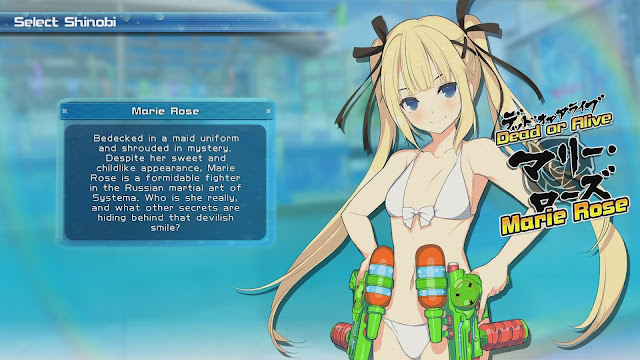 |
| Marie Rose made an appearance in Senran Kagura: Peach Beach Splash |
“I think Marie Rose is closer to reality than an anime, but we have not made her completely realistic. There are realistic elements to her, but she has no laugh lines or wrinkles, she has big eyes, and we are using our secret ‘cuteness technique’ so that she has an allure that is not seen in real women. We as creators work hard to provide that kind of allure, for people that can’t find it in the real world.”
Of course, it is only in recent years where technology has progressed to the point where digital celebrities can act as supernormal stimuli. Hatsune Miku, as the first genuine example of a digital celebrity that transcended to become part of “reality,” was only introduced in 2007 – just 13 years ago. There were efforts to bring sex appeal and celebrity to video games previously – Tomb Raider, was first released in 1996 for instance, but the technology made those efforts clumsy. Lara Croft’s triangle breasts, big as they were, weren’t going to be mistaken by anyone as a particularly effective supernormal stimuli.
Because the emergence of these digital celebrities is such a new thing, it’s all going through the technology adoption curve, where early adopters are enthusiastic, but the mainstream finds it all a little incomprehensible. Certainly the idea of attraction to digital characters still, for most, conjures images of the most uncouth of nerds, hiding out in their parent’s room doing God-knows-what in front of their computers.
 |
| Marie Rose has been on the cover of each version of Dead or Alive Xtreme 3, as the most popular choice she has been the “face” of the game. |
But there is a sense that there’s an acceptance of this coming through. Large communities of perfectly normal, adjusted people are forming around their favourite digital celebrities, and we’re starting to see the real potential of these beings to enhance a person’s life. Perhaps those people aren’t living their lives to the tastes of those that have an issue with supernormal stimuli would want… but really, it’s none of their business anyway.
“Initially, all this stuff was seen as content for otaku who are uncomfortable with real women, and it was niche and embarrassing,” Shimbori said. “But now we have a generation who grew up with digital media and characters as a fact of life and are now adults. The technology has also advanced, and as a result of all of this people’s lifestyles have become closer to the digital world.
“Additionally, the visual quality of games and anime has gone up, and the amount that is out there has exploded. As it becomes a part of popular culture, I think that a change of recognition has occurred. Now, characters that were thought to be strange become respected as the forefront of technology, and a new culture has formed around them, and now a character becomes anticipated as a creation that bestows an infinite future.”
So, are Hatsune Miku and Marie Rose ever going to play together?
At the end of the interview with Shimbori and Saito, I couldn’t help myself but ask; ever since I saw that official image of Miku and Marie Rose together I haven’t been able to get it out of my head – I so badly want those two to team up for something. I don’t even really care what.
“I just have to know,” I said. “I still have that Marie Rose X Hatsune Miku wallpaper on my computer. Just when are we going to get Miku into Dead or Alive (or Xtreme)?”
“I am not the ongoing producer of DOAX, but I don’t think there are any plans,” Shimbori laughed. “For Dead or Alive, Miku cannot be exposed to violence, and on top of that the aesthetics are completely different so it would be difficult. But, if there is an opportunity at some point, I would be happy to see her next to us. In anticipation of one day having such an opportunity, I hope for everyone’s kind support of our games!”
I let Shimbori have that plug. Because if you haven’t yet, you really should give Dead or Alive 6 and/or Dead or Alive Xtreme 3 a go. They’re both great games, and Marie Rose really is perfection.


